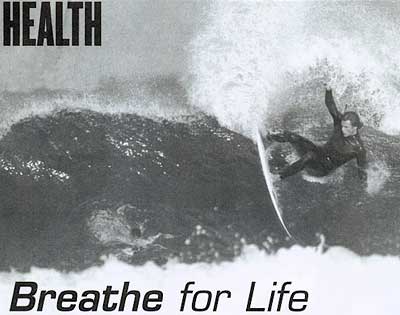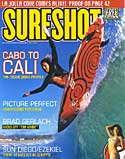SURFSHOT MAGAZINE, APRIL 2004
Chris Abad demonstrates the benefits of heavy breathing.
Photo: Ron GallegosWhich can you live the longest without? Breathing, food, or water? Seems like a pretty obvious question. Yet I'd bet most people take breathing for granted. Breath is life, and to breathe properly is to have more vitality, energy, focus, and relaxation. Certainly elements that would increase your health, and your surfing.
Photo: StraleyWant to see a perfect example of breathing? Watch a baby breathe. No physical obstacles like tense stomach, inflexible rib cage, or poor posture. No mental stress or tension, just pure natural uninhibited breath. No opinions or judgments created by a life of stress. Just a relaxed body, which is the door to good breath control.
There are 3 separate levels of breathing. Diaphragmatic, intercostal and clavicular. The ideal breath combines all three.
Diaphragmatic breathing is when the breath is drawn in, the diaphragm lowers and the abdominal region swells. Good breath control starts here.
Intercostal breathing is achieved by raising the chest and the thoracic ribs. It's quite common for athletes to breathe this way, however, it takes more effort and allows less air to enter.
Raising the shoulders and collarbone while inhaling is clavicular breathing. Only the upper lungs are fully functional. A complete breath begins at the diaphragm. Swells the abdominals, then the chest, and ribs naturally, allowing the lungs to completely fill up to the collarbones.
The average rate of breath is 12-14 times a minute. The optimal healthy rate is 6 breathes per minute. If you're breathing 12-14 times per minute you're in a slight state of hyperventilation. Taking quick shallow breaths reduces the level of carbon dioxide in your body. This causes the arteries to constrict, thus reducing the flow of blood through the body. Lack of oxygen switches on the sympathetic nervous system (fight or flight reflex) making us tense and anxious. Not the best way to feel when being held under.
Grant Washburn, big wave charger and part of the Mavericks crew, told me he almost drowned once. Not at Mavericks, Sunset or Waimea, but on a 6ft day at Ocean Beach, in S.F. On this relatively small day for Grant, he used poor judgment on a wave and took a spill. While under he was tense and angry about the mistake he'd made. That quickly changed to survival mode when he realized that his tension and anger had spent all his energy and he was in danger of drowning. He later laughed, "Can you imagine a big wave rider drowning in these conditions? Embarassing."
There are several yoga breathing techniques that are optimal exercises for surfers. In yoga, "Pranayama" is the science of breath control. These are very powerful exercises that consist of series, from basic to an advanced techniques. Keep in mind that these should be learned and practiced with an experienced yoga instructor.
In Health and Fitness
Paul Frediani / C.H.E.K. Level 1 / NLS 1
www.surfflex.com


